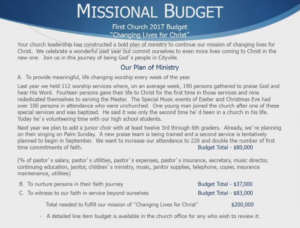A NEW STEWARDSHIP TOOL
Even if your church is well-attended each week and you’re receiving more tithe and offerings than the previous year, it’s likely you don’t have all the funds you need to impact the surrounding community through outreach ministry. Are you frustrated that funds always seem to be in short supply, and do you have an action plan to change that? “You Get What You Measure” is a popular fundraising axiom that can help.
Far too many churches focus on money, not the donor, so fundraising reports are income-based and cumulative. Without granular details of what is transpiring with the donors themselves, all religious organizations can do is fret over current shortfalls and hope for the best. While hope in eternal salvation is good, it is not a fundraising strategy!
Philanthropic Service for Institutions (PSI) at the North American Division has a free donor analytics software—Stewardship Analyzer—for treasurers and pastors. It provides much more actionable information than you would ever think to ask, and it has already benefited hundreds of Seventh-day Adventist institutions.
This incredible tool analyzes every donation made to the local church. It reports gains and losses in number of donors, number of donations, average donations, and cumulative donation changes. Stewardship Analyzer provides a holistic view of member giving. It also provides an indicator of members’ generosity commitment. Moreover, the tool analyzes member giving patterns and detects underlying problems early. Doing so empowers local stewardship leaders to proactively take steps to develop discipleship strategies that grow generosity while avoiding negatively impacting missional capacity.
The Stewardship Analyzer uses just three anonymous data points: (1) Donor ID Number, (2) Donation Date, and (3) Donation Amount to quickly produce insightful, easy-to-read reports that measure the monthly financial support your congregation provides and tracks your efforts to increase giving.
WHAT EXPERTS ARE SAYING
Lori Hunter Overmyer, a fundraising consultant who teaches the Keeping You Donors workshop for the Association of Fundraising Professionals says, “If I knew 20 years ago what these reports tell me, I wouldn’t have relied mostly on prayer as a methodology to get through the year. When donor retention drops below 75%, I immediately adjust my communication and appreciation strategies. I have frequently achieved annual increases of 10% or more.”
Dr. Adrian Sargeant, one of the top 10 most influential people in fundraising, stresses the importance of maintaining financial supporters. Based on his nonprofit research, he says, “A 10% improvement in retention can lead to a 150% increase in the lifetime value of an individual donor.”
DATA-DRIVEN COURSE CORRECTION
An Adventist pastor’s first church had only thirty members attending weekly, despite having a capacity of 400. After praying for wisdom on how to improve, the pastor realized he needed to research the treasury records. What he learned surprised him; several elders and administrative team members were not faithfully returning their tithes and offerings, and the treasurer had taken money for personal use. The pastor talked privately with each of these members and prayed with them about these spiritual matters.
After preaching a series on coming closer to Jesus and being faithful in returning tithes and offerings, God blessed in a special way. Members began returning their tithes and offerings, and they experienced the blessings of the Lord. They were also compelled to share their faith in the community. By God’s grace, forty new members were baptized in the next seven months! The church was revived, and the financial situation improved significantly.
HOW CAN I GET STARTED WITH STEWARDSHIP ANALYZER?
Export your church’s three anonymous data points: (1) Donor ID Number, (2) Donation Date, and (3) Donation Amount into Excel. Be sure to provide every single offering and every tithe donation received for the last seven years. Note that these are not cumulative totals, but every single donation given (as illustrated below). Then attach the file and email it to randyfox@nadadventist.org. Your data will be confidentially processed in the order received, summary reports will be emailed to you, and a Zoom review can be scheduled to discuss and clarify the findings if desired.
SAMPLE DATA EXPORT FILE
| DONOR ID | GIFT DATE | AMOUNT |
| 100001 | 9/7/2016 | 15 |
| 100001 | 4/12/2017 | 100 |
| 100001 | 3/21/2018 | 100 |
| 100001 | 7/8/2022 | 47 |
| 100001 | 3/25/2023 | 50 |
ADDITIONAL STEPS FOR IMMEDIATE IMPROVEMENT
In addition to using the Stewardship Analyzer, there are other methods used by professional fundraisers that can be useful and easily applied to fundraising in the local church.
Impactful Donor-Centered Communication
- Recognize that a mindset of lack by the church leadership can cause negativity in communication, which leads to low giving levels.
- Begin thinking of your members as donors. Strive to capture the imagination of members by communicating specifically how lives are being changed by a relationship with your church, and how the world is better because you are achieving your mission of saving souls for God’s Kingdom. Vision and mission inspire generous giving.
- Tell stories focusing on the joy of giving, rather than just the persistent, ongoing need.
- Interview members about how making a sacrificial gift has blessed them.
- Tell and show members all the great things accomplished this year, and include a few things you envision accomplishing next year, before asking for additional support.
- Weekly, write a heartfelt, one- to two-sentence thank you note to five faithful volunteers affirming their support and involvement. It makes them aware the church values their contribution. Research shows that affirming positive behaviors is the best way to encourage repetition.
- Research recommends thanking donors 7 times. You can’t say thank you too often. This can be done through simple methods like adding a hand-written note on typed thank you letters, expressing gratitude in the church bulletin, or verbally thanking supporters from the podium for generosity with money and volunteerism. Genuine gratitude builds strong bonds and deep relationships between donors and the mission they support. It also increases loyal systematic giving.
- In addition to thanking those members who support your ministry, challenge them to increase their financial commitment 1-3% per month.
- Consider sending donation receipts quarterly, and include a personal note of appreciation highlighting the impact of gifts.
“The cause must catch the eye, warm the heart and stir the mind.” (Harold Seymour)
Courageous and Effective Asking
- Consider using a Missional Budget, which illustrates in what specific ways and to what degree in-reach and outreach programs are transforming lives (see below). Avoid using line-item budgets in bulletins and online that may be misinterpreted without detailed explanations.

- Don’t hesitate to make multiple invitations to give. The need for money is evidence your church is alive and serving others. Emphasize that the gospel is free, but the pipeline that carries it is not. Remember, people want to help by giving their time and money to the church, but most people need to be asked before they act. Giving opportunities help members develop closer relationships with Jesus. Under-communicating is likely a far bigger problem than over-communicating. When you ask for support, you are asking members to partner in a ministry that they want to happen.
- You have a unique opportunity to speak in person, weekly, with your best supporters. Plan carefully what you will say for every appeal to ensure it is compelling. Most often, supporters want to hear inspiring stories about a transformative impact before they contribute. Members want to feel a sense of partnership in meaningful ministry where their financial assistance is integral to the health and vitality of the church.
People give to vision and causes! Proverbs 29:18 says, “Where there is no vision, the people perish.”
Visions of Expanding Ministry
- Communicate your Spirit-inspired vision for expanding ministry by listing five objectives in the bulletin monthly. Also list them permanently on your website. Highlight the resources needed to make those God-sized dreams a reality. People prefer to fund vision and dreams rather than debt reduction.
- Pledging is an effective means of raising large amounts of money quickly. About 70% of signed pledges are fulfilled, but you’ll have to systematically remind and encourage donors about their commitment.
To explore the topic of fundraising in greater depth, consider PSI’s free online five-part fundraising course for pastors, church administrators, and board members on the Adventist Learning Community (ALC), entitled Understanding and Implementing Fundraising. It emphasizes Biblically-based principles of giving and explains principles and crucial components that must be followed for appeals to be successful.
Visit PhilanthropicService.com for many other resources like tutorial fundraising videos, a lending library of fundraising books on a wide array of topics, grant searches to identify potential funders for special projects, and a handbook entitled Successful Fundraising.

By Randy Fox
Randy has a decade of frontline experience analyzing data which empowers Adventist organizations, ministries, and churches to become much more effective at raising sustainable income.